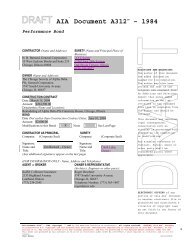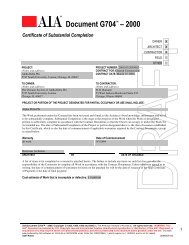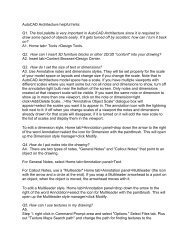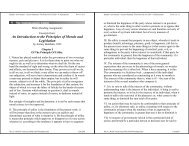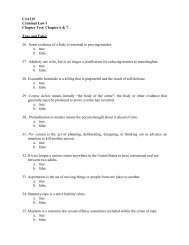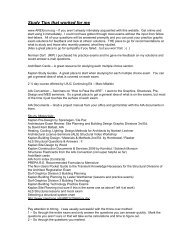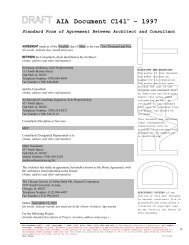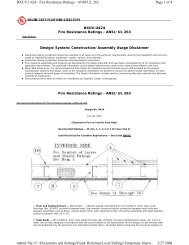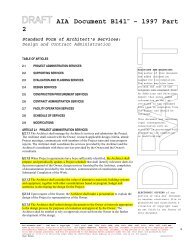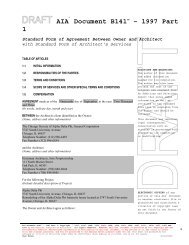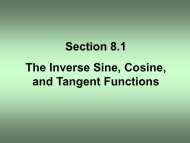Trigonometric Functions
Trigonometric Functions
Trigonometric Functions
Create successful ePaper yourself
Turn your PDF publications into a flip-book with our unique Google optimized e-Paper software.
1<br />
<strong>Trigonometric</strong><br />
<strong>Functions</strong><br />
Copyright © 2009 Pearson Addison-Wesley<br />
1.1-1
1 <strong>Trigonometric</strong> <strong>Functions</strong><br />
1.1 Angles<br />
1.2 Angle Relationships and Similar<br />
Triangles<br />
1.3 <strong>Trigonometric</strong> <strong>Functions</strong><br />
1.4 Using the Definitions of the<br />
<strong>Trigonometric</strong> <strong>Functions</strong><br />
Copyright © 2009 Pearson Addison-Wesley<br />
1.1-2
1.1<br />
Angles<br />
Basic Terminology Degree Measure Standard Position<br />
Coterminal Angles<br />
Copyright © 2009 Pearson Addison-Wesley 1.1-3<br />
1.1-3
Basic Terminology<br />
Two distinct points determine line AB.<br />
Line segment AB—a portion of the line between A<br />
and B, including points A and B.<br />
Ray AB—portion of line AB that starts at A and<br />
continues through B, and on past B.<br />
Copyright © 2009 Pearson Addison-Wesley<br />
1.1-4
Basic Terminology<br />
An angle consists of two<br />
rays in a plane with a<br />
common endpoint.<br />
The two rays are the<br />
sides of the angle.<br />
The common endpoint is<br />
called the vertex of the<br />
angle.<br />
Copyright © 2009 Pearson Addison-Wesley<br />
1.1-5
An angle’s measure is<br />
generated by a rotation<br />
about the vertex.<br />
The ray in its initial<br />
position is called the<br />
initial side of the angle.<br />
The ray in its location<br />
after the rotation is the<br />
terminal side of the<br />
angle.<br />
Basic Terminology<br />
Copyright © 2009 Pearson Addison-Wesley<br />
1.1-6
Basic Terminology<br />
Positive angle: The<br />
rotation of the terminal<br />
side of an angle is<br />
counterclockwise.<br />
Negative angle: The<br />
rotation of the terminal<br />
side is clockwise.<br />
Copyright © 2009 Pearson Addison-Wesley<br />
1.1-7
Types of Angles<br />
The most common unit for measuring angles is the<br />
degree.<br />
A complete rotation of a<br />
ray gives an angle<br />
whose measure is 360 .<br />
of complete rotation gives an angle<br />
whose measure is 1 .<br />
Copyright © 2009 Pearson Addison-Wesley<br />
1.1-8
Types of Angles<br />
Angles are classified by their measures.<br />
Copyright © 2009 Pearson Addison-Wesley<br />
1.1-9
Example 1<br />
FINDING THE COMPLEMENT AND THE<br />
SUPPLEMENT OF AN ANGLE<br />
For an angle measuring 40 , find the measure of<br />
its (a) complement and (b) supplement.<br />
(a) To find the measure of its complement, subtract<br />
the measure of the angle from 90 .<br />
Complement of 40 .<br />
(b) To find the measure of its supplement, subtract<br />
the measure of the angle from 180 .<br />
Supplement of 40 .<br />
Copyright © 2009 Pearson Addison-Wesley 1.1-10<br />
1.1-10
Example 2<br />
Find the measure of<br />
each marked angle.<br />
Since the two angles form<br />
a right angle, they are<br />
complementary.<br />
FINDING MEASURES OF<br />
COMPLEMENTARY AND<br />
SUPPLEMENTARY ANGLES<br />
Combine terms.<br />
Divide by 9.<br />
Determine the measure of each angle by substituting<br />
10 for x:<br />
Copyright © 2009 Pearson Addison-Wesley 1.1-11<br />
1.1-11
Example 2<br />
Find the measure of<br />
each marked angle.<br />
Since the two angles form<br />
a straight angle, they are<br />
supplementary.<br />
FINDING MEASURES OF<br />
COMPLEMENTARY AND<br />
SUPPLEMENTARY ANGLES (continued)<br />
The angle measures are and .<br />
Copyright © 2009 Pearson Addison-Wesley 1.1-12<br />
1.1-12
Degrees, Minutes, Seconds<br />
One minute is 1/60 of a degree.<br />
One second is 1/60 of a minute.<br />
Copyright © 2009 Pearson Addison-Wesley<br />
1.1-13
Example 3<br />
CALCULATING WITH DEGREES,<br />
MINUTES, AND SECONDS<br />
Perform each calculation.<br />
(a)<br />
(b)<br />
Add degrees<br />
and minutes<br />
separately.<br />
Write 90 as<br />
89 60′.<br />
Copyright © 2009 Pearson Addison-Wesley 1.1-14<br />
1.1-14
Example 4<br />
Find the sum or difference.<br />
CONVERTING BETWEEN DECIMAL<br />
DEGREES AND DEGREES, MINUTES,<br />
AND SECONDS<br />
(a)<br />
(b)<br />
Add degrees<br />
and minutes<br />
separately.<br />
Write 90 as<br />
89 60′.<br />
Copyright © 2009 Pearson Addison-Wesley 1.1-15<br />
1.1-15
Standard Position<br />
An angle is in standard position if its vertex is at<br />
the origin and its initial side is along the positive<br />
x-axis.<br />
Copyright © 2009 Pearson Addison-Wesley<br />
1.1-16
Quandrantal Angles<br />
Angles in standard position having their<br />
terminal sides along the x-axis or y-axis,<br />
such as angles with measures 90 , 180 ,<br />
270 , and so on, are called quadrantal<br />
angles.<br />
Copyright © 2009 Pearson Addison-Wesley 1.1-17<br />
1.1-17
Coterminal Angles<br />
A complete rotation of a ray results in an angle<br />
measuring 360 . By continuing the rotation, angles<br />
of measure larger than 360 can be produced.<br />
Such angles are called coterminal angles.<br />
The measures of coterminal angles differ by 360 .<br />
Copyright © 2009 Pearson Addison-Wesley<br />
1.1-18
Example 5<br />
FINDING MEASURES OF<br />
COTERMINAL ANGLES<br />
Find the angle of least possible positive measure<br />
coterminal with an angle of 908 .<br />
Add or subtract 360 as<br />
many times as needed to<br />
obtain an angle with<br />
measure greater than 0 but<br />
less than 360 .<br />
An angle of 908 is coterminal with an angle of 188 .<br />
Copyright © 2009 Pearson Addison-Wesley 1.1-19<br />
1.1-19
Example 5<br />
FINDING MEASURES OF<br />
COTERMINAL ANGLES (continued)<br />
Find the angle of least possible positive measure<br />
coterminal with an angle of –75 .<br />
Add or subtract 360 as<br />
many times as needed to<br />
obtain an angle with<br />
measure greater than 0 but<br />
less than 360 .<br />
An angle of –75 is coterminal with an angle of 285 .<br />
Copyright © 2009 Pearson Addison-Wesley 1.1-20<br />
1.1-20
Example 5<br />
FINDING MEASURES OF<br />
COTERMINAL ANGLES (continued)<br />
Find the angle of least possible positive measure<br />
coterminal with an angle of –800 .<br />
The least integer multiple of<br />
360 greater than 800 is<br />
An angle of –800 is coterminal with an angle of 280 .<br />
Copyright © 2009 Pearson Addison-Wesley 1.1-21<br />
1.1-21
Coterminal Angles<br />
To find an expression that will generate all angle<br />
coterminal with a given angle, add integer<br />
multiples of 360 to the given angle.<br />
For example, the expression for all angles<br />
coterminal with 60 is<br />
Copyright © 2009 Pearson Addison-Wesley<br />
1.1-22
Coterminal Angles<br />
Copyright © 2009 Pearson Addison-Wesley<br />
1.1-23
Example 6<br />
ANALYZING THE REVOLUTIONS OF A<br />
CD PLAYER<br />
CAV (Constant Angular Velocity) CD players always<br />
spin at the same speed. Suppose a CAV player<br />
makes 480 revolutions per minute. Through how<br />
many degrees will a point on the edge of a CD move<br />
in two seconds.<br />
Copyright © 2009 Pearson Addison-Wesley 1.1-24<br />
1.1-24
Example 6<br />
ANALYZING THE REVOLUTIONS OF A<br />
CD PLAYER<br />
Solution<br />
The player revolves 480 times in one minute or<br />
times = 8 times per second.<br />
In two seconds, the player will revolve<br />
times.<br />
Each revolution is 360 , so a point on the edge of the<br />
CD will revolve<br />
in two seconds.<br />
Copyright © 2009 Pearson Addison-Wesley 1.1-25<br />
1.1-25
1<br />
<strong>Trigonometric</strong><br />
<strong>Functions</strong><br />
Copyright © 2009 Pearson Addison-Wesley 1.2-1
1 <strong>Trigonometric</strong> <strong>Functions</strong><br />
1.1 Angles<br />
1.2 Angle Relationships and Similar<br />
Triangles<br />
1.3 <strong>Trigonometric</strong> <strong>Functions</strong><br />
1.4 Using the Definitions of the<br />
<strong>Trigonometric</strong> <strong>Functions</strong><br />
Copyright © 2009 Pearson Addison-Wesley 1.2-2
1.2<br />
Angle Relationships and<br />
Similar Triangles<br />
Geometric Properties Triangles<br />
Copyright © 2009 Pearson Addison-Wesley 1.1-3 1.2-3
Vertical Angles<br />
Vertical angles have equal measures.<br />
The pair of angles NMP and<br />
RMQ are vertical angles.<br />
Copyright © 2009 Pearson Addison-Wesley 1.1-4 1.2-4
Parallel Lines<br />
Parallel lines are lines that lie in the same plane<br />
and do not intersect.<br />
When a line q intersects<br />
two parallel lines, q, is<br />
called a transversal.<br />
Copyright © 2009 Pearson Addison-Wesley 1.2-5
Angles and Relationships<br />
Name<br />
Alternate interior angles<br />
Alternate exterior angles<br />
Interior angles on the same<br />
side of the transversal<br />
Corresponding angles<br />
Angles<br />
4 and 5<br />
3 and 6<br />
1 and 8<br />
2 and 7<br />
4 and 6<br />
3 and 5<br />
2 & 6, 1 & 5,<br />
3 & 7, 4 & 8<br />
Rule<br />
Angles measures are equal.<br />
Angle measures are equal.<br />
Angle measures add to 180 .<br />
Angle measures are equal.<br />
Copyright © 2009 Pearson Addison-Wesley 1.2-6
Example 1<br />
FINDING ANGLE MEASURES<br />
Find the measure of angles 1, 2, 3, and 4, given<br />
that lines m and n are parallel.<br />
Angles 1 and 4 are<br />
alternate exterior angles,<br />
so they are equal.<br />
Subtract 3x.<br />
Add 40.<br />
Divide by 2.<br />
Angle 1 has measure<br />
Substitute 21<br />
for x.<br />
Copyright © 2009 Pearson Addison-Wesley 1.1-7 1.2-7
Example 1<br />
FINDING ANGLE MEASURES (continued)<br />
Angle 4 has measure<br />
Substitute 21<br />
for x.<br />
Angle 2 is the supplement of<br />
a 65 angle, so it has<br />
measure .<br />
Angle 3 is a vertical angle to angle 1, so its measure<br />
is 65 .<br />
Copyright © 2009 Pearson Addison-Wesley 1.1-8 1.2-8
Angle Sum of a Triangle<br />
The sum of the measures of the angles of<br />
any triangle is 180 .<br />
Copyright © 2009 Pearson Addison-Wesley 1.1-9 1.2-9
Example 2<br />
APPLYING THE ANGLE SUM OF A<br />
TRIANGLE PROPERTY<br />
The measures of two of the angles of a<br />
triangle are 48 and 61 . Find the measure<br />
of the third angle, x.<br />
The sum of the<br />
angles is 180 .<br />
Add.<br />
Subtract 109 .<br />
The third angle of the triangle measures 71 .<br />
Copyright © 2009 Pearson Addison-Wesley 1.1-10 1.2-10
Types of Triangles: Angles<br />
Copyright © 2009 Pearson Addison-Wesley 1.2-11
Types of Triangles: Sides<br />
Copyright © 2009 Pearson Addison-Wesley 1.2-12
Conditions for Similar<br />
Triangles<br />
For triangle ABC to be similar to triangle<br />
DEF, the following conditions must hold.<br />
1. Corresponding angles must have the<br />
same measure.<br />
2. Corresponding sides must be<br />
proportional. (That is, the ratios of the<br />
corresponding sides must be equal.)<br />
Copyright © 2009 Pearson Addison-Wesley 1.1-13 1.2-13
Example 3<br />
FINDING ANGLE MEASURES IN SIMILAR<br />
TRIANGLES<br />
In the figure, triangles ABC and NMP are similar.<br />
Find the measures of angles B and C.<br />
Since the triangles are similar, corresponding angles<br />
have the same measure.<br />
B corresponds to M, so angle B measures 31 .<br />
C corresponds to P, so angle C measures 104 .<br />
Copyright © 2009 Pearson Addison-Wesley 1.1-14 1.2-14
Example 4<br />
FINDING SIDE LENGTHS IN SIMILAR<br />
TRIANGLES<br />
In the figure, triangles ABC and NMP are similar.<br />
Find the measures of angles B and C.<br />
Since the triangles are similar, corresponding sides<br />
are proportional.<br />
DF corresponds to AB, and DE corresponds to AC,<br />
so<br />
Copyright © 2009 Pearson Addison-Wesley 1.1-15 1.2-15
Example 4<br />
FINDING SIDE LENGTHS IN SIMILAR<br />
TRIANGLES (continued)<br />
Side DF has length 12.<br />
EF corresponds to CB, so<br />
Side EF has length 16.<br />
Copyright © 2009 Pearson Addison-Wesley 1.1-16 1.2-16
Example 5<br />
FINDING THE HEIGHT OF A FLAGPOLE<br />
Firefighters at a station need to measure the height<br />
of the station flagpole. They find that at the instant<br />
when the shadow of the station is 18 m long, the<br />
shadow of the flagpole is 99 ft long. The station is<br />
10 m high. Find the height of the flagpole.<br />
Since the two triangles<br />
are similar, corresponding<br />
sides are proportional.<br />
Copyright © 2009 Pearson Addison-Wesley 1.1-17 1.2-17
Example 5<br />
FINDING THE HEIGHT OF A FLAGPOLE<br />
(continued)<br />
Lowest terms<br />
The flagpole is 55 feet high.<br />
Copyright © 2009 Pearson Addison-Wesley 1.1-18 1.2-18
1<br />
<strong>Trigonometric</strong><br />
<strong>Functions</strong><br />
Copyright © 2009 Pearson Addison-Wesley 1.3-1
1 <strong>Trigonometric</strong> <strong>Functions</strong><br />
1.1 Angles<br />
1.2 Angle Relationships and Similar<br />
Triangles<br />
1.3 <strong>Trigonometric</strong> <strong>Functions</strong><br />
1.4 Using the Definitions of the<br />
<strong>Trigonometric</strong> <strong>Functions</strong><br />
Copyright © 2009 Pearson Addison-Wesley 1.3-2
1.3<br />
<strong>Trigonometric</strong> <strong>Functions</strong><br />
<strong>Trigonometric</strong> <strong>Functions</strong><br />
Quadrantal Angles<br />
Copyright © 2009 Pearson Addison-Wesley 1.1-3 1.3-3
<strong>Trigonometric</strong> <strong>Functions</strong><br />
Let (x, y) be a point other the origin on the terminal<br />
side of an angle in standard position. The<br />
distance from the point to the origin is<br />
Copyright © 2009 Pearson Addison-Wesley 1.3-4
<strong>Trigonometric</strong> <strong>Functions</strong><br />
The six trigonometric functions of θ are<br />
defined as follows:<br />
Copyright © 2009 Pearson Addison-Wesley 1.1-5 1.3-5
Example 1<br />
FINDING FUNCTION VALUES OF AN<br />
ANGLE<br />
The terminal side of angle in standard position<br />
passes through the point (8, 15). Find the values of<br />
the six trigonometric functions of angle .<br />
Copyright © 2009 Pearson Addison-Wesley 1.1-6 1.3-6
Example 1<br />
FINDING FUNCTION VALUES OF AN<br />
ANGLE (continued)<br />
Copyright © 2009 Pearson Addison-Wesley 1.1-7 1.3-7
Example 2<br />
FINDING FUNCTION VALUES OF AN<br />
ANGLE<br />
The terminal side of angle in standard position<br />
passes through the point (–3, –4). Find the values<br />
of the six trigonometric functions of angle .<br />
Copyright © 2009 Pearson Addison-Wesley 1.1-8 1.3-8
Example 2<br />
FINDING FUNCTION VALUES OF AN<br />
ANGLE (continued)<br />
Use the definitions of the trigonometric functions.<br />
Copyright © 2009 Pearson Addison-Wesley 1.1-9 1.3-9
Example 3<br />
FINDING FUNCTION VALUES OF AN<br />
ANGLE<br />
Find the six trigonometric function values of the<br />
angle θ in standard position, if the terminal side of θ<br />
is defined by x + 2y = 0, x ≥ 0.<br />
We can use any point on<br />
the terminal side of to<br />
find the trigonometric<br />
function values.<br />
Choose x = 2.<br />
Copyright © 2009 Pearson Addison-Wesley 1.1-10 1.3-10
Example 3<br />
FINDING FUNCTION VALUES OF AN<br />
ANGLE (continued)<br />
The point (2, –1) lies on the terminal side, and the<br />
corresponding value of r is<br />
Multiply by<br />
the denominators.<br />
to rationalize<br />
Copyright © 2009 Pearson Addison-Wesley 1.1-11 1.3-11
Example 4(a)<br />
FINDING FUNCTION VALUES OF<br />
QUADRANTAL ANGLES<br />
Find the values of the six trigonometric functions for<br />
an angle of 90 .<br />
The terminal side passes<br />
through (0, 1). So x = 0, y = 1,<br />
and r = 1.<br />
undefined<br />
undefined<br />
Copyright © 2009 Pearson Addison-Wesley 1.1-12 1.3-12
Example 4(b)<br />
FINDING FUNCTION VALUES OF<br />
QUADRANTAL ANGLES<br />
Find the values of the six<br />
trigonometric functions for an<br />
angle θ in standard position<br />
with terminal side through<br />
(–3, 0).<br />
x = –3, y = 0, and r = 3.<br />
undefined<br />
undefined<br />
Copyright © 2009 Pearson Addison-Wesley 1.1-13 1.3-13
Undefined Function Values<br />
If the terminal side of a quadrantal angle lies along<br />
the y-axis, then the tangent and secant functions<br />
are undefined.<br />
If the terminal side of a quadrantal angle lies along<br />
the x-axis, then the cotangent and cosecant<br />
functions are undefined.<br />
Copyright © 2009 Pearson Addison-Wesley 1.1-14 1.3-14
Commonly Used Function<br />
Values<br />
<br />
sin <br />
cos <br />
tan <br />
cot <br />
sec <br />
csc <br />
0<br />
0<br />
1<br />
0<br />
undefined<br />
1<br />
undefined<br />
90<br />
1<br />
0<br />
undefined<br />
0<br />
undefined<br />
1<br />
180<br />
0<br />
1<br />
0<br />
undefined<br />
1<br />
undefined<br />
270<br />
1<br />
0<br />
undefined<br />
0<br />
undefined<br />
1<br />
360<br />
0<br />
1<br />
0<br />
undefined<br />
1<br />
undefined<br />
Copyright © 2009 Pearson Addison-Wesley 1.3-15
Using a Calculator<br />
A calculator is degree mode<br />
returns the correct values<br />
for sin 90 and cos 90 .<br />
The second screen shows<br />
an ERROR message for tan<br />
90 because 90 is not in<br />
the domain of the tangent<br />
function.<br />
Copyright © 2009 Pearson Addison-Wesley 1.3-16
Caution<br />
One of the most common errors<br />
involving calculators in trigonometry<br />
occurs when the calculator is set for<br />
radian measure, rather than degree<br />
measure.<br />
Copyright © 2009 Pearson Addison-Wesley 1.1-17 1.3-17
1<br />
<strong>Trigonometric</strong><br />
<strong>Functions</strong><br />
Copyright © 2009 Pearson Addison-Wesley 1.4-1
1 <strong>Trigonometric</strong> <strong>Functions</strong><br />
1.1 Angles<br />
1.2 Angle Relationships and Similar<br />
Triangles<br />
1.3 <strong>Trigonometric</strong> <strong>Functions</strong><br />
1.4 Using the Definitions of the<br />
<strong>Trigonometric</strong> <strong>Functions</strong><br />
Copyright © 2009 Pearson Addison-Wesley 1.4-2
1.4<br />
Using the Definitions of the<br />
<strong>Trigonometric</strong> <strong>Functions</strong><br />
Reciprocal Identities Signs and Ranges of Function Values<br />
Pythagorean Identities Quotient Identities<br />
Copyright © 2009 Pearson Addison-Wesley 1.1-3 1.4-3
Reciprocal Identities<br />
For all angles θ for which both functions are<br />
defined,<br />
Copyright © 2009 Pearson Addison-Wesley 1.1-4 1.4-4
Example 1(a)<br />
USING THE RECIPROCAL IDENTITIES<br />
Since cos θ is the reciprocal of sec θ,<br />
Copyright © 2009 Pearson Addison-Wesley 1.1-5 1.4-5
Example 1(b)<br />
USING THE RECIPROCAL IDENTITIES<br />
Since sin θ is the reciprocal of csc θ,<br />
Rationalize the<br />
denominator.<br />
Copyright © 2009 Pearson Addison-Wesley 1.1-6 1.4-6
Signs of Function Values<br />
in<br />
Quadrant<br />
sin <br />
cos <br />
tan <br />
cot <br />
sec <br />
csc <br />
I<br />
+<br />
+<br />
+<br />
+<br />
+<br />
+<br />
II<br />
+<br />
<br />
<br />
<br />
<br />
+<br />
III<br />
<br />
<br />
+<br />
+<br />
<br />
<br />
IV<br />
<br />
+<br />
<br />
<br />
+<br />
<br />
Copyright © 2009 Pearson Addison-Wesley 1.4-7
Ranges of Function Values<br />
Copyright © 2009 Pearson Addison-Wesley 1.4-8
Example 2<br />
DETERMINING SIGNS OF FUNCTIONS<br />
OF NONQUADRANTAL ANGLES<br />
Determine the signs of the trigonometric functions of<br />
an angle in standard position with the given measure.<br />
(a) 87<br />
The angle lies in quadrant I, so all of its<br />
trigonometric function values are positive.<br />
(b) 300<br />
The angle lies in quadrant IV, so the cosine and<br />
secant are positive, while the sine, cosecant,<br />
tangent, and cotangent are negative.<br />
Copyright © 2009 Pearson Addison-Wesley 1.1-9 1.4-9
Example 2<br />
DETERMINING SIGNS OF FUNCTIONS<br />
OF NONQUADRANTAL ANGLES (cont.)<br />
Determine the signs of the trigonometric functions of<br />
an angle in standard position with the given measure.<br />
(c) –200<br />
The angle lies in quadrant II, so the sine and<br />
cosecant are positive, while the cosine, secant,<br />
tangent, and cotangent are negative.<br />
Copyright © 2009 Pearson Addison-Wesley 1.1-10 1.4-10
Example 3<br />
IDENTIFYING THE QUADRANT OF AN<br />
ANGLE<br />
Identify the quadrant (or quadrants) of any angle <br />
that satisfies the given conditions.<br />
(a) sin > 0, tan < 0.<br />
Since sin > 0 in quadrants I and II, and tan < 0 in<br />
quadrants II and IV, both conditions are met only in<br />
quadrant II.<br />
(b) cos > 0, sec < 0<br />
The cosine and secant functions are both negative<br />
in quadrants II and III, so could be in either of<br />
these two quadrants.<br />
Copyright © 2009 Pearson Addison-Wesley 1.1-11 1.4-11
Ranges of <strong>Trigonometric</strong><br />
<strong>Functions</strong><br />
Copyright © 2009 Pearson Addison-Wesley 1.1-12 1.4-12
Example 4<br />
DECIDING WHETHER A VALUE IS IN<br />
THE RANGE OF A TRIGONOMETRIC<br />
FUNCTION<br />
Decide whether each statement is possible or<br />
impossible.<br />
(a) sin θ = 2.5<br />
Impossible<br />
(b) tan θ = 110.47<br />
Possible<br />
(c) sec θ = .6<br />
Impossible<br />
Copyright © 2009 Pearson Addison-Wesley 1.1-13 1.4-13
Example 5<br />
FINDING ALL FUNCTION VALUES<br />
GIVEN ONE VALUE AND THE<br />
QUADRANT<br />
Suppose that angle is in quadrant II and<br />
Find the values of the other five trigonometric<br />
functions.<br />
Choose any point on the terminal side of angle .<br />
Let r = 3. Then y = 2.<br />
Since is in quadrant II,<br />
Copyright © 2009 Pearson Addison-Wesley 1.1-14 1.4-14
Example 5<br />
FINDING ALL FUNCTION VALUES<br />
GIVEN ONE VALUE AND THE<br />
QUADRANT (continued)<br />
Remember to<br />
rationalize the<br />
denominator.<br />
Copyright © 2009 Pearson Addison-Wesley 1.1-15 1.4-15
Example 5<br />
FINDING ALL FUNCTION VALUES<br />
GIVEN ONE VALUE AND THE<br />
QUADRANT (continued)<br />
Copyright © 2009 Pearson Addison-Wesley 1.1-16 1.4-16
Pythagorean Identities<br />
For all angles θ for which the function values are<br />
defined,<br />
Copyright © 2009 Pearson Addison-Wesley 1.1-17 1.4-17
Quotient Identities<br />
For all angles θ for which the denominators are<br />
not zero,<br />
Copyright © 2009 Pearson Addison-Wesley 1.1-18 1.4-18
Example 6<br />
FINDING OTHER FUNCTION VALUES<br />
GIVEN ONE VALUE AND THE<br />
QUADRANT<br />
Choose the positive<br />
square root since sin θ >0.<br />
Copyright © 2009 Pearson Addison-Wesley 1.1-19 1.4-19
Example 6<br />
FINDING OTHER FUNCTION VALUES<br />
GIVEN ONE VALUE AND THE<br />
QUADRANT (continued)<br />
To find tan θ, use the quotient identity<br />
Copyright © 2009 Pearson Addison-Wesley 1.1-20 1.4-20
Caution<br />
In problems like those in Examples 5<br />
and 6, be careful to choose the<br />
correct sign when square roots are<br />
taken.<br />
Copyright © 2009 Pearson Addison-Wesley 1.1-21 1.4-21
Example 7<br />
FINDING OTHER FUNCTION VALUES<br />
GIVEN ONE VALUE AND THE<br />
QUADRANT<br />
Find sin θ and cos θ, given that<br />
quadrant III.<br />
and θ is in<br />
Since θ is in quadrant III, both sin θ and cos θ are<br />
negative.<br />
Copyright © 2009 Pearson Addison-Wesley 1.1-22 1.4-22
Example 7<br />
FINDING OTHER FUNCTION VALUES<br />
GIVEN ONE VALUE AND THE<br />
QUADRANT (continued)<br />
Caution<br />
It is incorrect to say that sin θ = –4<br />
and cos θ = –3, since both sin θ and<br />
cos θ must be in the interval [–1, 1].<br />
Copyright © 2009 Pearson Addison-Wesley 1.1-23 1.4-23
Example 7<br />
FINDING OTHER FUNCTION VALUES<br />
GIVEN ONE VALUE AND THE<br />
QUADRANT (continued)<br />
Use the identity<br />
to find sec θ. Then<br />
use the reciprocal identity to find cos θ.<br />
Choose the negative<br />
square root since sec θ
Example 7<br />
FINDING OTHER FUNCTION VALUES<br />
GIVEN ONE VALUE AND THE<br />
QUADRANT (continued)<br />
Choose the negative<br />
square root since sin θ
Example 7<br />
FINDING OTHER FUNCTION VALUES<br />
GIVEN ONE VALUE AND THE<br />
QUADRANT (continued)<br />
This example can also be<br />
worked by drawing θ is<br />
standard position in quadrant<br />
III, finding r to be 5, and then<br />
using the definitions of sin θ<br />
and cos θ in terms of x, y,<br />
and r.<br />
Copyright © 2009 Pearson Addison-Wesley 1.1-26 1.4-26



